Sat in 2nd place in the Bundesliga, 1 point off leaders Bayern Munich, Union Berlin are certainly in the hat for a top-four spot, currently eclipsing the likes of Borussia Dortmund, RB Leipzig and Eintracht Frankfurt, and may even have whispers of a potential Bundesliga title race on the horizon.
Urs Fischer has led this team to unimaginable heights, and with over half of the season already completed, he has shown everyone just how much you can achieve through a proper plan and a solid tactical set-up.
Union Berlin have managed to score 33 goals in 19 games, a figure which is not too dissimilar from many other teams in the mid-table spots. However, they have been much better defensively than their counterparts. Many of their games are close stalemates, but set-pieces have often been the key to unlocking games. With 12 goals scored from dead ball situations (excluding penalties), over a third of their goals have come from either corners or free kicks. In addition, 8 of those goals were scored to put Union Berlin in winning positions, and considering the fact that they have won 12 games this season, it is clear that set-pieces have been the key to making the breakthrough in most games.
In this tactical analysis, we will delve into the tactics used by Union Berlin during attacking set plays, with an analysis of how they have created so many match-winners from them. This set-piece analysis will look at the different methods they’ve used when attacking corners and free kicks, and why this unpredictability will make Die Eisernen difficult to stop.
Use of screens
Union Berlin’s most frequent and effective method of chance creation from set plays, whether that is a free kick or a corner, has been through their use of screens that are coordinated in order to give the target player as much time and space as possible to perfect his header.
One way a screen can be used effectively is through the contact between the players coming in from behind the defender, This is known as a blindside screen. A blindside screen differs from a more traditional one because the contact is initiated from behind rather than in front or from the side of the defender. This method can be more effective than the traditional screen as defenders have no idea the screen is coming and so have to be extremely alert at all times.
Furthermore, a screen which comes from the goal side, means that the contact will push you away from goal and so the attacking player will have even more time and space to attack the ball.
The example below illustrates a screen coming in from the attacker in red. As the ‘screen’ is set up, the man marker is hit with the element of surprise, and so he must focus on regaining balance in the first place, whilst by that time, the attacker is already attacking the ball in the air.
Moreover, we can also see an Augsburg defender who is watching his man marker setting up the screen. In usual circumstances, the player who was supposed to be man-marking would swap roles, depending on their position, in relation to other players in the box. The player setting up the screen clearly has no interest in the free kick, so his original marker should mark the next nearest player still left open. However, due to the element of surprise, the defender freezes inside his own 18 yard-box and watches everyone dismark themselves from him.
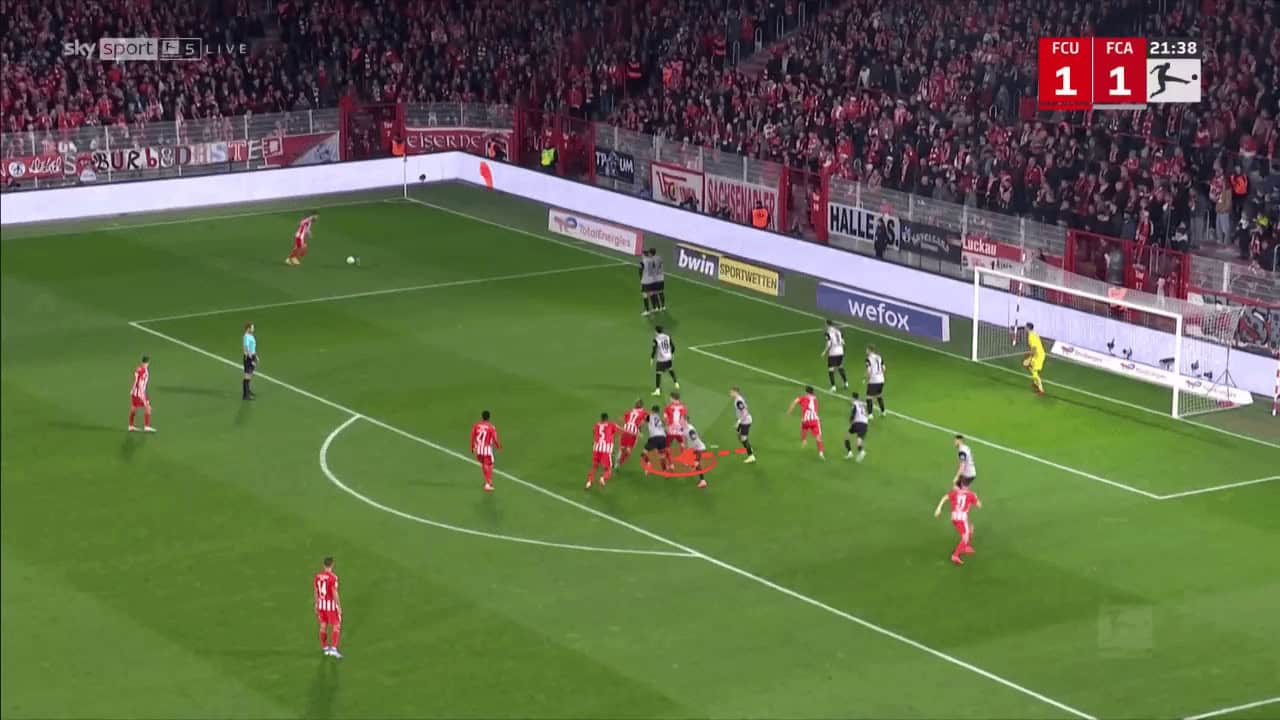
We can see pictured below, the original marker has stood still the entire time, whilst the attacker has stepped in front of him and is about to duel for the header.
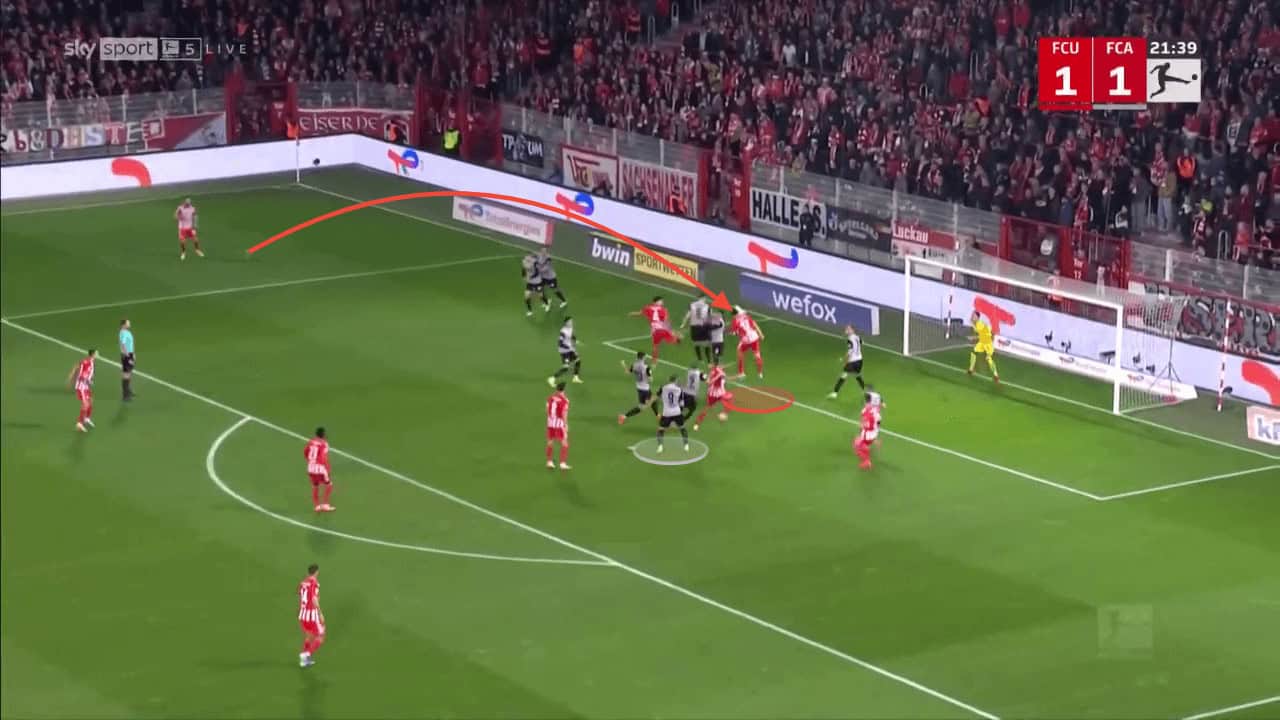
Another way in which Union Berlin have utilised screens is by targeting open spaces left by man marking defensive approaches. Defending 1v1 during crosses can be very difficult due to the high levels of concentration and awareness needed. Against setups with hardly any zonal markers, the space to attack for every Union Berlin individual massively increases.
As we can see below, the near post has been neglected, so there is lots of space for an easy delivery into the box. The screen then becomes active as we can see the player at the front post prevented his marker from being able to clear the ball, meaning that the front part of the six-yard box is accessible for all. All that is required from that point onwards is a driven cross into the space created preventing opposition defenders from having the time needed to get there and clear it. The nearest Berlin player enters a race with their marker, and if that Berlin player can create a yard of separation before the kick is taken, they can have a free effort on goal from within six yards.
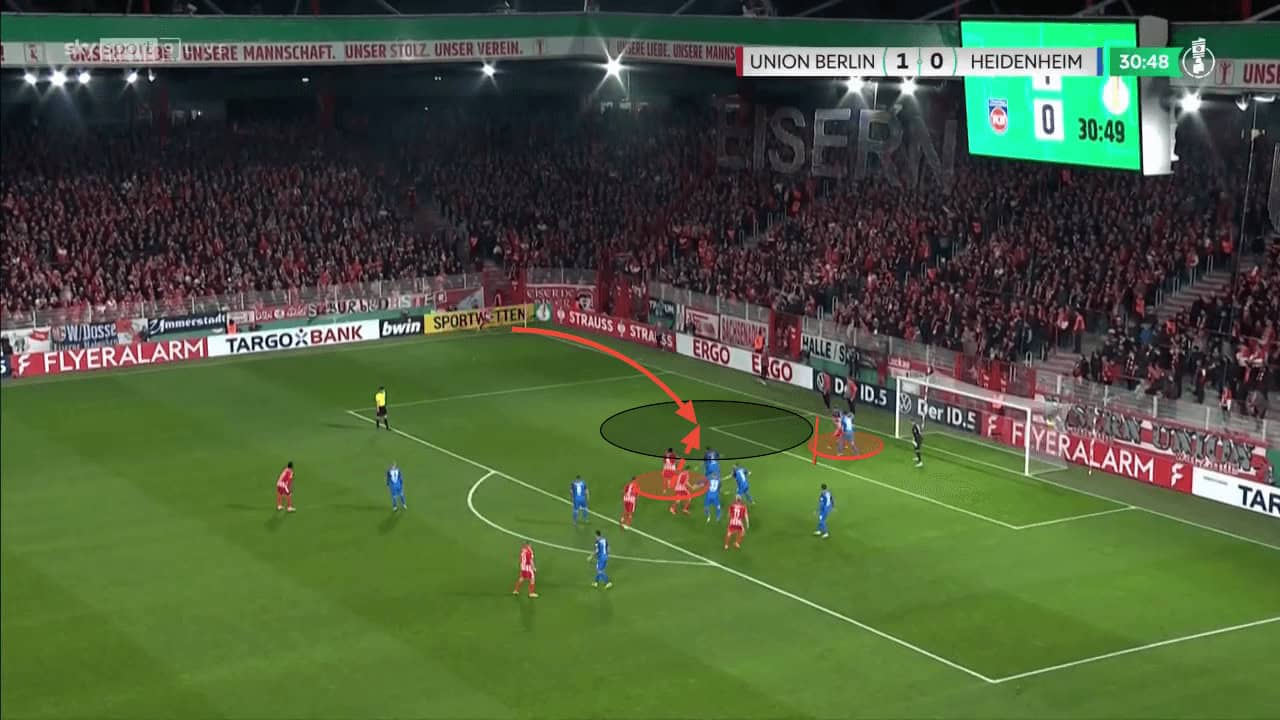
One final way screens have been highly effective for Union Berlin, is through their efforts to prevent goalkeepers from being able to come out and claim crosses. Forcing the keeper on his line means that the cross is less likely to be intercepted, and so the attacking side has a better chance of making the first contact.
As a result, the ball can be delivered into the six-yard box with no threat of being cleared and, as is common knowledge, a headed attempt from close range is theoretically at least easier to put into the back of the net. One key reason why this worked is that Union Berlin face, yet again, a heavy man-marking side, meaning that spaces can be exploited.
The defending team does a poor job with the marking, allowing each player too much space to attack the box, meaning they can get an unopposed sprint towards the goal which will allow them to easily outjump some of these players who are zonally marking and have a standing start.
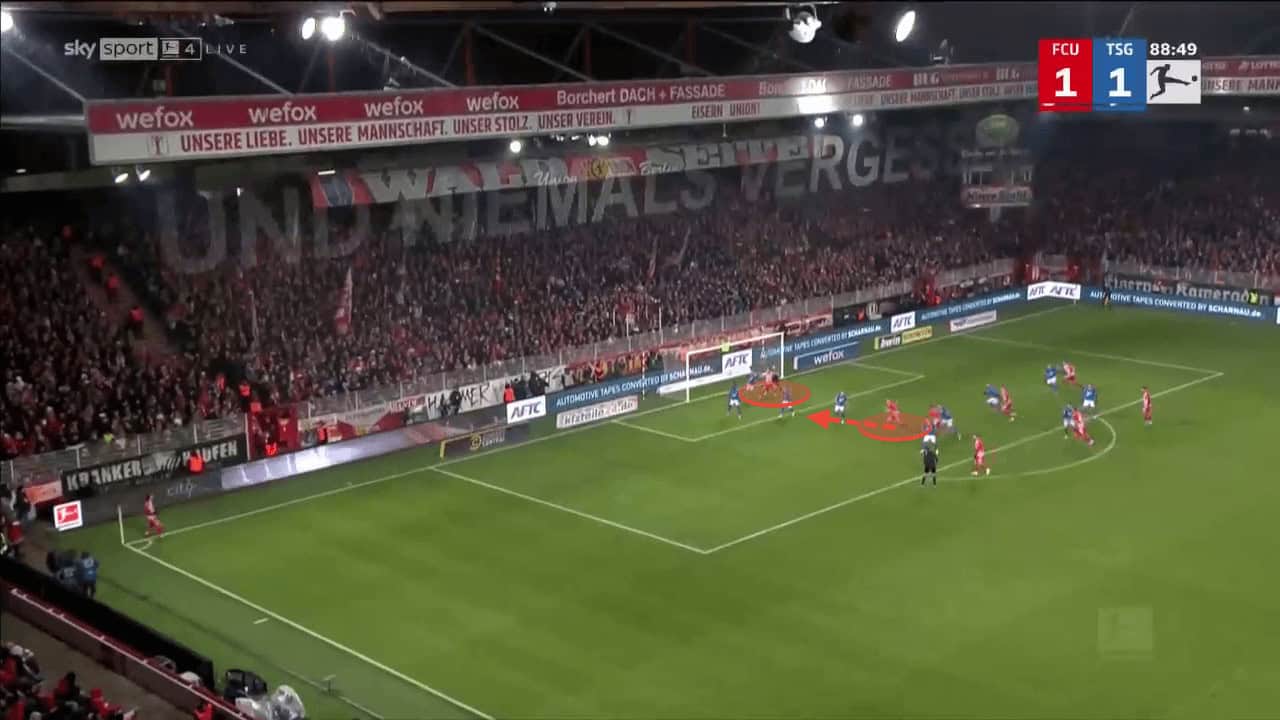
Short variations
Another way in which Union Berlin have become so threatening from set-pieces is their ability to mix up corner routines by passing the ball short. As with most defensive teams, their players’ eyes lock onto the ball rather than their assigned marker, meaning that it can become particularly easy for an attacker to dismark themselves, especially if they can move out of the last defender’s line of sight.
This example perfectly illustrates the fact that players naturally get drawn towards the ball, which opens up space near the back post. As the short pass is played, everyone takes steps towards the ball, limiting the space between the defensive block for the opposition to combine through. Nevertheless, that’s when Union Berlin deliberately have a player attack the back post. The crosser of the ball has the patience in his play to attract opposition pressure, before then releasing the ball when as much space as possible is available.
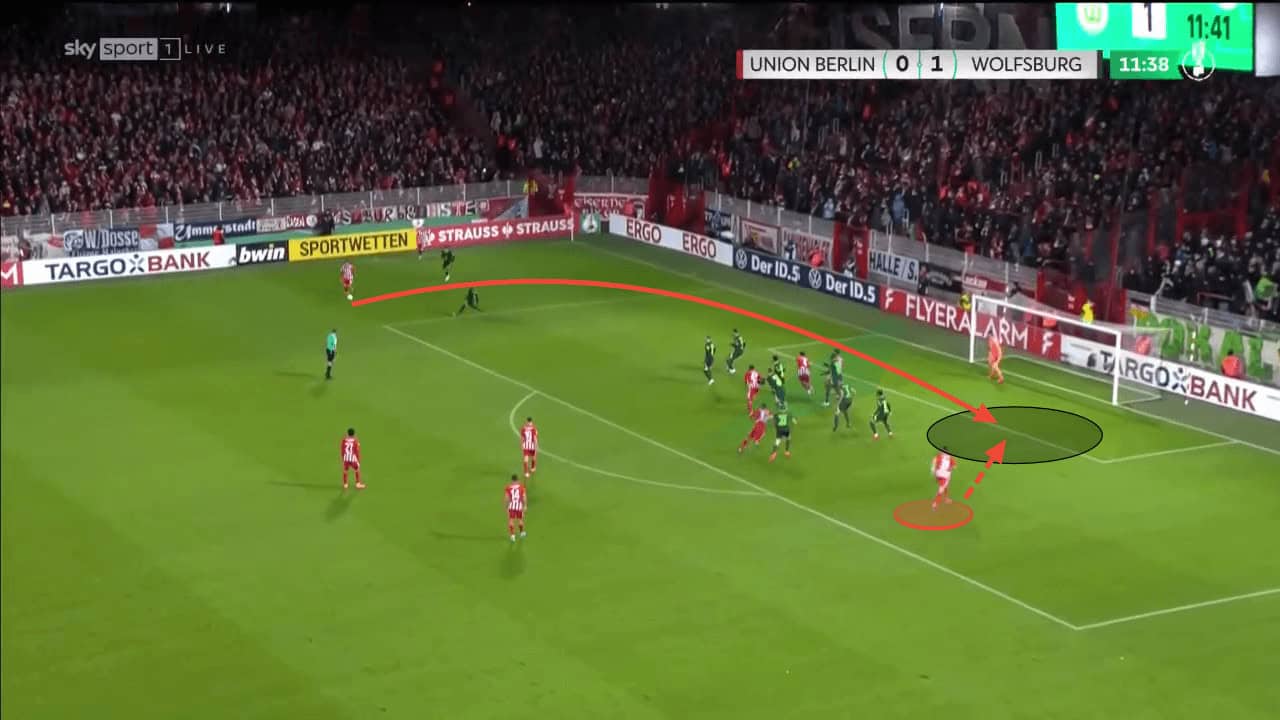
Below we can see another example of a short corner being played into a player in the corner of the 18-yard box. Another benefit of having the crossing position moved closer to the goal, at a decreased angle, is that there is the possibility of the cross being untouched, but still making its way into the opponent’s goal.
The image below displays the potential trajectory of the cross, where it has the chance of going into the back of the net, even if everyone on the pitch missed the header. As a result, defenders have to be more cautious in their approach, making sure that they know they will be able to connect with the ball. Goalkeepers also have to be more risk averse, staying on their line rather than risking stepping out of position and having an attacker get a slight touch of the ball ahead of them.
When the defence sits deeper, goalkeepers may feel more inclined to collect the ball and relieve their teams of any pressure but run the risk of an attacker making minimal contact with the ball first, and it leading to a goal.
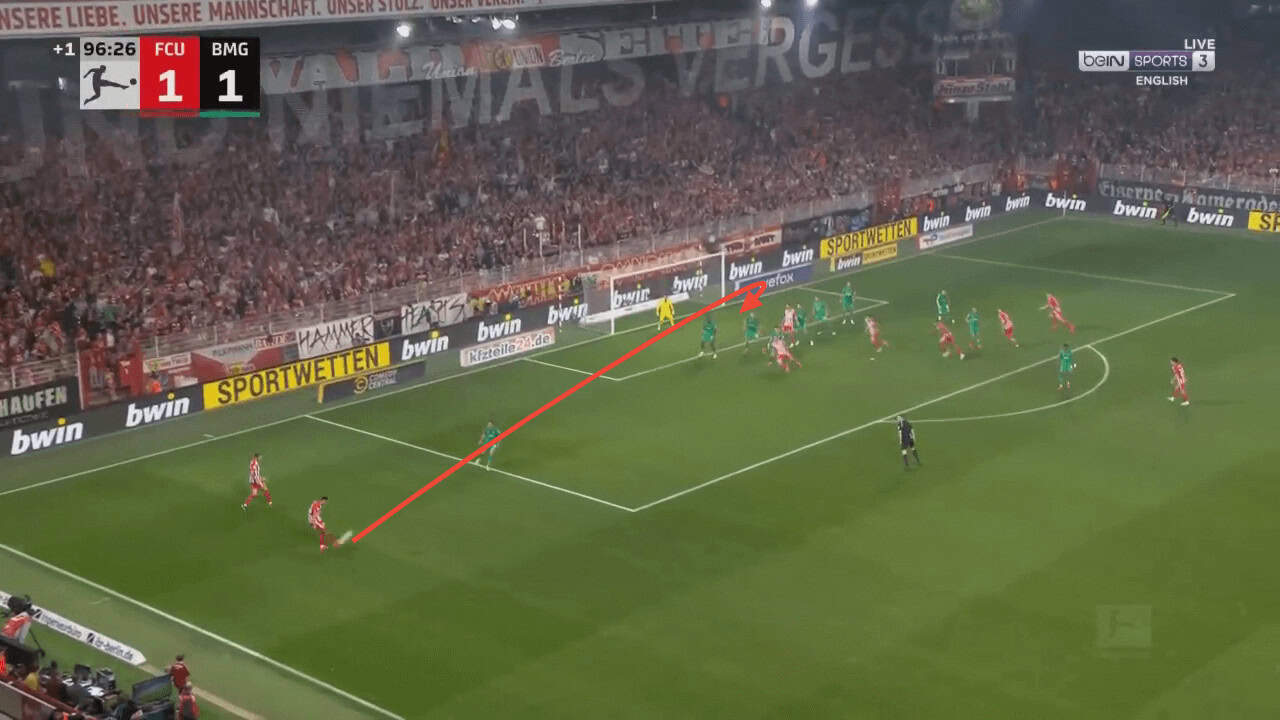
As we mentioned earlier, an important point for Union Berlin is making the most of those runners from deep who can easily outjump static defenders, thanks to their new starting positions. Below, we can see another example of a Union Berlin player who started on the edge of the box and provided a threatening option because of the length of their run-up. The deeper starting position allows the Berlin players to sprint towards the cross, and with the help of the inswinging cross, they only need a little touch of the ball for it to end up in the back of the net.
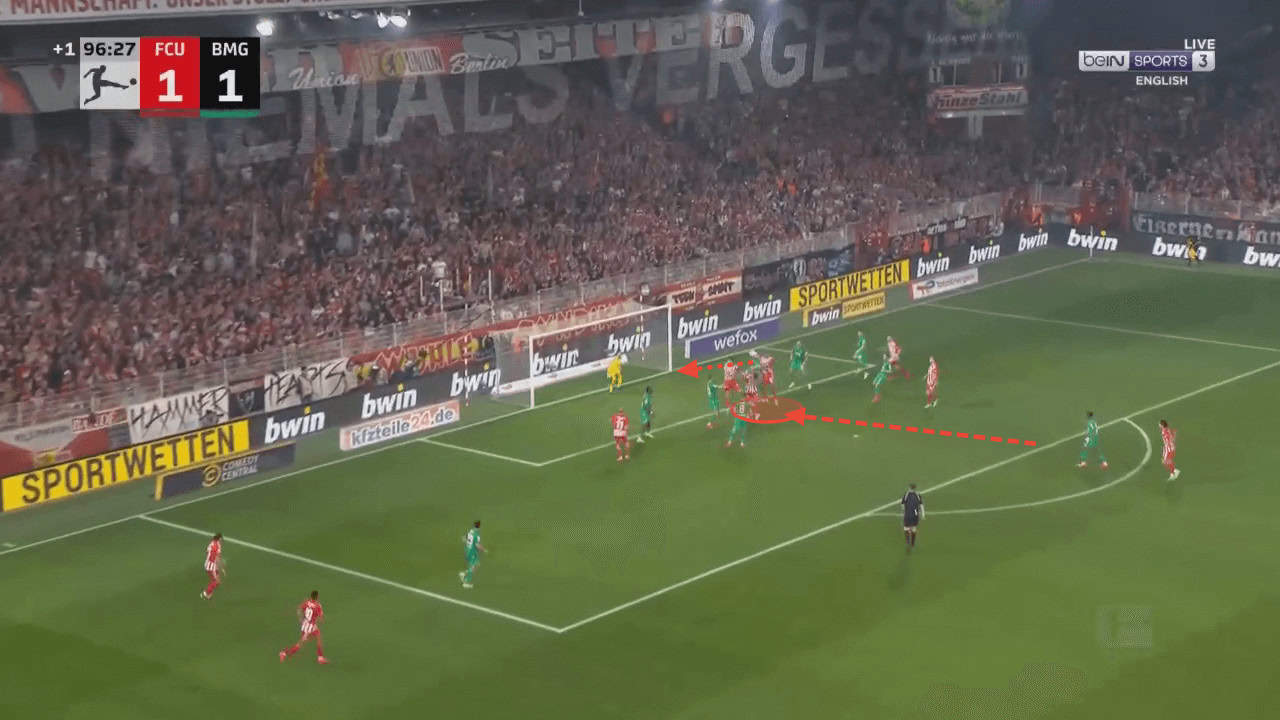
One final way in which Union Berlin have created numerous dangerous chances is through the use of decoy runs. A decoy run is made by a player who pretends as if they will have any involvement in a play but is purely there to capture the defender’s attention, thus creating more space for extra teammates.
In the example below, we can see the Union Berlin player make a darting run into the box but the position of the run is the most interesting part. The goal for Berlin is to find the player at the back post and they help him have space by targeting the defender nearest to the back post and distracting it. As the plan sets into action, we can see a decoy run purposefully being made across the face of Alphonso Davies, the player nearest the back post.
As he sees the run, he begins to track the movement, prioritising the run with intent. However, Davies is already occupied with someone and is left with a 2v1 at the bottom of the screen. It’s impossible to be in two places at once, and so one of these players must have space, which ends up with Sheraldo Becker having a volley on goal from inside the box.
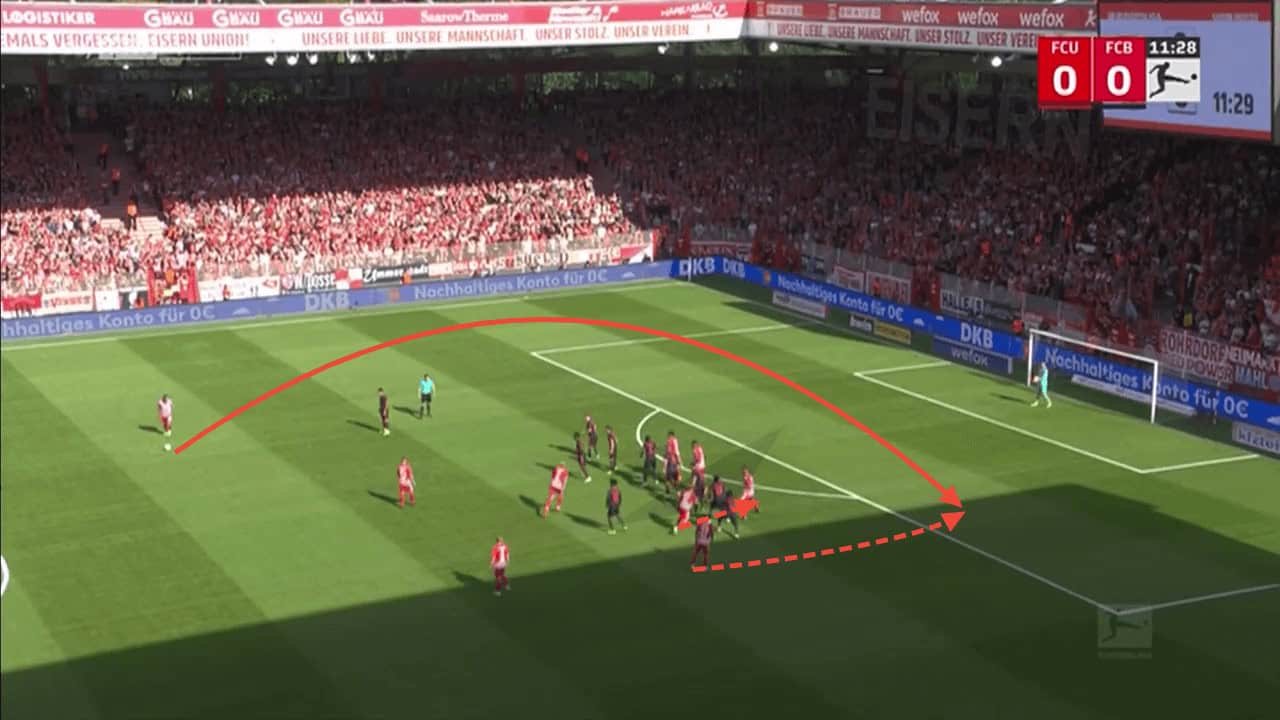
Summary
This set-piece analysis has detailed the many wonderful and different methods Union Berlin have utilised this season in their pursuit of the UEFA Champions League spots and maybe even the Bundesliga title.
Union Berlin are a creative side who have utilised a wide variety of set-piece routines to consistently gain an edge over their opponents week in and week out. From decoy runs to screens, to targeting deliveries into specific zones, Union have proven their credentials as one of the most dangerous teams from set-pieces this season.






Comments